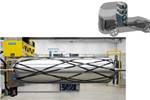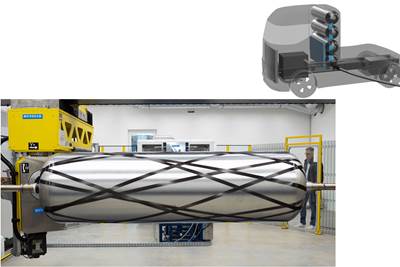Nikola introduces hydrogen energy brand HYLA
HYLA brand highlights integrated H2 solutions, 60 hydrogen stations installed by 2026 and access to 300 metric tons of H2 per day.
The HYLA flexible mobile fueler solution cools and compresses hydrogen to rapidly fill 700-bar FCEV heavy-duty trucks. Photo Credit, all images: Nikola Corp.
(Phoenix, Ariz., U.S.) a heavy-duty commercial battery-electric vehicles (BEVs), fuel cell electric vehicles (FCEVs) and energy solutions manufacturer, has created a new global brand, , to encompass the company’s energy products for producing, distributing and dispensing hydrogen to fuel its zero-emissions trucks.
“The HYLA brand represents Nikola’s hydrogen-focused energy business by supporting our fuel cell electric vehicles and those of other OEMs,” Carey Mendes, president, Nikola Energy, says. “Hydrogen energy is the catalyst for the HYLA brand and serves as a forward-looking solution for our customers to help them achieve their sustainability goals and dramatically reduce the overall carbon emissions in the transportation sector.”
According to Nikola CEO and President Michael Lohscheller, the company is successfully integrating the hydrogen fuel cell truck and the full hydrogen energy infrastructure supply chain under one roof. This is emphasized through the unveiling of Nikola’s Tres fuel cell truck and flexible mobile fueling trailer.
Under the HYLA brand, Nikola is developing access of up to 300 metric tons per day (TPD) of hydrogen. This supply is expected to be supported by the previously announced projects referenced below, which are being developed with Nikola partners:
- City of Buckeye, : Phased development of up to 150 metric TPD;
- Terre Haute, Indiana : 50 metric TPD;
- Crossfield, Alberta : 60 metric TPD;
- Clinton County, Pennsylvania : 100 metric TPD.
-
Plug Power: Multi-region offtake agreement of up to 125 metric TPD;
Located in Buckeye, Ariz., U.S., the Phoenix Hydrogen Hub (PHH) is expected to be built in phases to scale with the demand created from Nikola’s zero-emission trucks in the Southwest region, starting with 30 metric tons in the first phase, and up to 150 metric TPD of hydrogen in future phases. Construction of the first phase is anticipated to be completed in the second half of 2024, once final investment decisions and customary regulatory approvals are finalized.
With the intent to have 60 hydrogen stations in place by 2026, the first three announced HYLA hydrogen stations will be in California in Colton, Ontario, and a location servicing the Port of Long Beach.
HYLA hydrogen stations, mobile fueler
With the intent to have 60 hydrogen stations in place by 2026 under HYLA, in Colton, Ontario, and a location servicing the Port of Long Beach. California is a launch market for Nikola and these stations intend to support key customers to help advance the state’s efforts to decarbonize the transport sector.
Moreover, HYLA will highlight a , an integral part of Nikola’s flexible customer service in its early years by distributing hydrogen to its FCEV customers at locations which meet their needs. The mobile fueler cools and compresses hydrogen to rapidly fill 700-bar FCEV heavy-duty trucks. Coupled with a hydrogen tube trailer with a capacity of 960 kilograms, the mobile fueler can reportedly refuel customer trucks back to back.
The mobile fueler program includes its own mobile fuelers as well as a number of third party mobile fuelers, which will provide Nikola customers with a variety of flexible fueling options.
The first mobile fueler has completed commissioning and testing and has been released for market operation. Nikola has additional hydrogen mobile fuelers being commissioned in Q1 2023.
Related Content
Polar Technology develops innovative solutions for hydrogen storage
Conformable “Hydrogen in a Box” prototype for compressed gas storage has been tested to 350 and 700 bar, liquid hydrogen storage is being evaluated.
Read MoreThermoplastic composite pipes provide 59% reduction in H2 distribution CO2 emissions
Hive Composites’ multilayer thermoplastic composite pipe (TPC) design meets hydrogen permeation requirements while ensuring substantial CO2 reductions compared to conventional steel pipe systems.
Read MoreComposite pressure vessels enable future energy storage
Q&A between Hexagon Purus, Infinite Composites and Hyosung USA delves into the future of H2 storage, including scalability and production goals, materials and application trends and other dynamics.
Read MoreBraided thermoplastic composite H2 tanks with co-consolidated molded boss areas to fit EV battery space
BRYSON project demonstrates possible designs, automated manufacturing and low permeability concepts, including EVOH liner and novel PPA matrix.
Read MoreRead Next
Cryo-compressed hydrogen, the best solution for storage and refueling stations?
Cryomotive’s CRYOGAS solution claims the highest storage density, lowest refueling cost and widest operating range without H2 losses while using one-fifth the carbon fiber required in compressed gas tanks.
Read MoreUltrasonic welding for in-space manufacturing of CFRTP
Agile Ultrasonics and NASA trial robotic-compatible carbon fiber-reinforced thermoplastic ultrasonic welding technology for space structures.
Read MoreNext-gen fan blades: Hybrid twin RTM, printed sensors, laser shock disassembly
MORPHO project demonstrates blade with 20% faster RTM cure cycle, uses AI-based monitoring for improved maintenance/life cycle management and proves laser shock disassembly for recycling.
Read More












